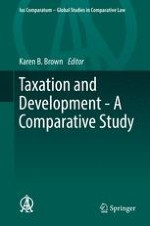Synopsis
Following the majority, Poland taxes its resident companies on their worldwide income. Companies are resident if their effective place of management is in Poland. A credit for foreign taxes paid helps to alleviate the potential for double taxation when another country also subjects the income to taxation. The credit may not exceed the Polish tax liability on the foreign source income. Nonresidents are taxed on only income from Polish sources.
Dividends from foreign sources are taxed at the regular corporate tax rate of 19 % that applies to other income. Where a subsidiary is at least 75 %-owned, the Polish company may receive a credit for any taxes paid by the subsidiary on the profits distributed. A 19 % withholding tax applies to dividends paid by Polish companies unless a tax treaty provides otherwise.
Poland has entered into more than 90 tax treaties which follow either the OECD or UN Model treaties. The treaties contain both the exemption and tax credit methods. In the case of dividends received by Polish residents, for example, treaties either exempt the foreign source payment (e.g., Malaysia and Ireland) or provide for a reduced withholding tax rate. Poland is in the process of renegotiating treaties that provided a tax-sparing credit, believing that these were used improperly for tax avoidance purposes.
In legislation following the EU’s Parent-Subsidiary Directive, dividends received from companies resident in the EU, EEA, or Switzerland are exempt from Polish tax, if a minimum level of shareholding is met. To qualify for the exemption, shares must be held for at least 2 years before the distribution and the subsidiary must be subject to tax in the relevant jurisdiction on a worldwide basis.
There is a special regime for transactions with resident of countries deemed to be engaged in harmful tax competition. Under these rules, special documentation is required concerning transfer pricing. The Minister of Finance determines which tax regimes are “harmful,” a term not defined in the legislation, and publishes that list. Thirty-seven countries, many of which are developing countries, appear on the list.
As a member of the EU and of the OECD Global Form, Poland has moved to bring its tax system in line with accepted standards. This has caused it to pursue new tax policy initiatives, including renegotiating tax treaties to abolish tax sparing, updating exchange of information provisions, attempting to close loopholes in its tax system, and drafting new anti-tax avoidance rules (in the form of a General Anti-Abuse Rule or GAAR) and Controlled Foreign Corporation (CFC) legislation. These developments raise the question whether these changes will have the effect of reducing Poland’s attractiveness as an investment location. Addition of complexity into Poland tax regime and administration may make doing business in Poland less desirable. Introduction of CFC rules may decrease a competitive advantage now held by Polish investors.
Poland is a party to a robust network of information exchange on bilateral and multilateral fronts. It is also engaged in a campaign to expand information exchange with countries viewed as tax havens, having concluded information exchange agreements with Bahamas, Liberia, Isle of Man, Jersey, Guernsey, Belize, Andorra, Dominica, and others. Legislation has opened the door to exchange of information normally protected by bank secrecy laws.
As it transitioned from a socialist to a free market system, Poland adopted a number of tax incentives designed to attract foreign investment. These include special deductions for research and development centers, tax exemptions for investment in special underdeveloped economic zones, accelerated depreciation deductions for investments in certain assets, and temporary tax holiday for new businesses. While these measures are important tools to enable Poland to attract investment, they are viable only so long as they do not violate EU restrictions on State Aid.
Poland is a party to more than 60 bilateral trade and investment agreements.
